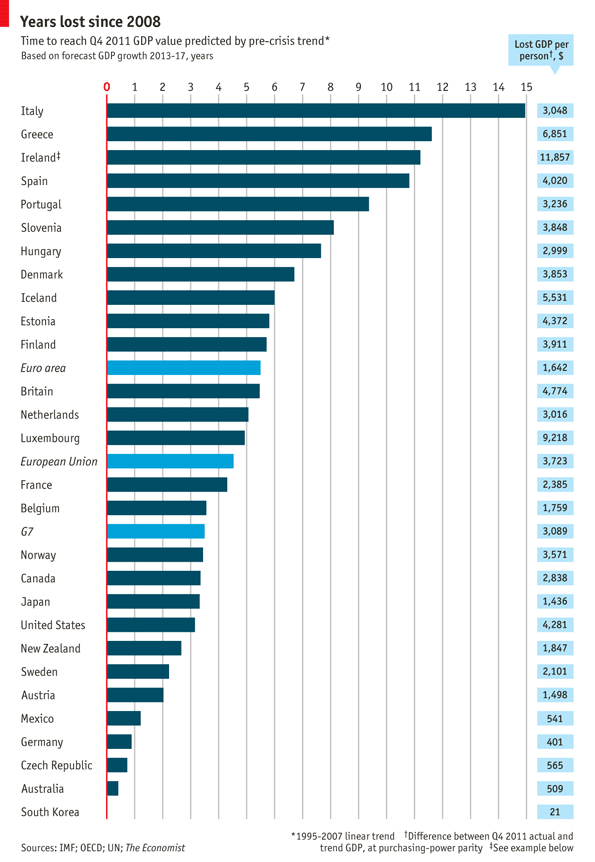Daily chart
每日图表
Lost time
浪费的时间
Apr 17th 2012, 15:09 by The Economist online
How many years of economic output has the rich world lost?
富裕国家浪费了多少年的经济产量?
SINCE the financial crisis struck in 2008, the economic output of most of the rich world has stalled. By the end of the last quarter of 2011, GDP in the 34 countries of the OECD was 6.8% lower than it would have been had it continued at its 1995-2007 trend growth rate of 2.7% on average. In monetary terms, that's $2,200 per person. According to the IMF's latest economic growth forecasts for the years up to 2017, released on April 17th, it will take OECD countries another 2.7 years to reach its pre-crisis trend level of economic output. Applying these calculations to individual countries level, it is clear that the PIIGS have become particularly stuck in the mud, as can be seen in the chart below.

4 小时前 上传
下载附件 (122.79 KB)

自2008年遭受金融危机以来,大多数富裕国家的经济产量都停滞不前。假若经合组织34个国家保持1995-2007年平均2.7%的速率增长,那么现在的经济产量与之相比要低出6.8个百分点。以金钱的形式看,即每人少2200美元。根据国际货币基金组织4月17日发布的到2017年的最新经济产量预测,经合组织国家要达到按危机前趋势发展的经济产量水平还需要另外2.7年。将这种估计应用到单个国家,正如下表所示,欧猪五国深陷泥潭一目了然。
Italy is the most deeply mired; forecasts suggest it will take 15 years to get back to where it would be now had the crisis not hit. Ireland has lost 11 years for different reasons; growth is forecast to be reasonably strong at 2.6% a year on average, but its pre-crisis trend growth rate was so high that it will take years to catch up (see the second chart below for an illustration of the linear trend gap). Not everyone has lost time. There are six OECD countries (Chile, Israel, Poland, Slovakia, Switzerland and Turkey) which have out-performed their pre-crisis growth trend, and are not shown here.

4 小时前 上传
下载附件 (59.3 KB)

意大利陷入泥潭最深,估计它将花上15年才能达到金融危机没有发生时发展到现在的水平。爱尔兰浪费了11年,这有许多原因。爱尔兰的年均增长率预计在合理的2.2%,但是金融危机前它的增长率相当之高,因此需要数年才能迎头赶上。(看第二张表示线性趋势缺口的图)。并不是每个国家都浪费了时间。有六个国家(智利、波兰、斯诺法克、瑞士、土耳其)在危机后的表现好于按危机之前趋势发展,此处并未显示。

 扫码加好友,拉您进群
扫码加好友,拉您进群